Zeiss Victory SF Binoculars
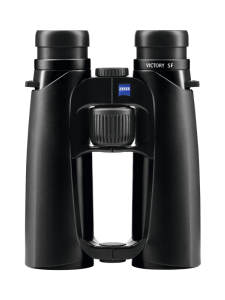 |
|
Click image to enlarge
|
|
Review Highlights
- Zeiss’ brilliant new nature observation binocular
- Gigantic field of view
- Excellent close focus of 4.9 feet
- Lighter weight, better balance, superior ergonomics
|
Zeiss recently brought out their newest premium nature observation roof prism binocular, the 42-mm Victory SF. With
the excellent Victory HT binoculars still on the market, the obvious question is: what makes these new high-end
binoculars different enough to sell side-by-side with the HTs? The Victory HTs are made with a brand new (then)
type of glass from Schott AG, which is designed for one thing: high light transmission. Indeed, they excel at it,
with 95% light throughput, the highest of any binocular on the market. Zeiss has recently discontinued the 42mm HTs
and introduced 54mm models, leaving the Victory SFs, which are optimized for a wider field of view, lower weight,
shorter close focus and generally better ergonomics as their premier binoculars for the nature observation market.
How well that all works is the rest of the review.
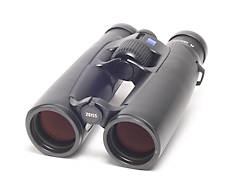 |
|
Click image to enlarge
|
The Victory SF binoculars again feature a brand new type of glass from Schott AG, this one called “Ultra FL” glass,
to indicate its higher fluoride content relative to normal optical glass. The internal lens system was re-designed
to use 7 lenses, 2 with the Ultra-FL glass, and including a field flattener lens for enhanced edge-to-edge image
sharpness while actually using less glass. These 7 lenses are arrayed differently within the ocular tubes,
re-distributing the weight forward towards the ocular end. Optically speaking, they deliver a fantastically crisp,
bright image, boasting about 92% light transmission meaning the SFs are still one of the brightest binoculars
available today. Both the 8x and 10x models of Victory SF binoculars have 18 mm of eye relief, more than enough
for comfortable use by almost anyone. One of the ways in which the Victory SF binoculars exceed virtually all
other 42-mm binoculars is their wide field of view. The 10x42 Victory SF has a 360-foot field of view at 1000 yards.
This would be about an average field of view… for an 8x binocular! The 8x42 Victory SF has a huge 444-foot field of
view at 1000 yards. This is simply outstanding performance in this regard. Naturally, Victory SF binoculars feature
all the usual refined coatings from Zeiss, including their proprietary T* full multi-coating, many layers of
dielectric coating on the prism faces and the LotuTec® coating on the lenses and eyepieces, which prevents water
and dirt from collecting on the glass surfaces and makes the SFs much easier to clean. The package works incredibly
well in the field, allowing discernment of fine detail at remarkable distances under any observation conditions.
Physical Characteristics
The first thing you notice about the Victory SF binoculars is that they have what Zeiss terms a “triple link bridge”
design, which is to say there are three bridges linking the two ocular tubes: one both above and below the focus knob,
and a third one down by the objective lenses. This shifts the focus knob more towards the objective end of the binocular,
which actually makes for more comfortable focusing because it leaves the forefingers more in line with the rest of the
hand when focusing. There is enough room between the middle linking bridge and the objective bridge for most users to
comfortably fit three fingers, something not all “open bridge” designs can achieve. Moreover, with the slenderness of
the Victory SF ocular tubes, we had no trouble getting three fingers from both hands into this space, something that
almost no other open bridge design can claim. This also means that you can wrap more of your fingers around those
slender ocular tubes, producing a very steady grip, which means an inherently more stable image for your viewing. There
is a ridge on the upper outer portion of each barrel that is perfectly placed to fall in the crease formed by the base
of your fingers as you grip the binocular. On the underside, a very slight beveling on the barrel beneath the armoring
itself falls right under the thumbs, leading to greater comfort and stability. There is the slightest bit of ribbing
beneath the thin armoring that imparts just a slightly better grip, a refined little design touch. The weight of the
Victory SFs is balanced ever so slightly towards the ocular end, so that they fall gently towards your face, rather
than pulling down and away. All these features combined make them extremely comfortable to hold and use, such that in
the course of a long day, you tend to forget that there is an optic between your eyes and what you are viewing. Both
Zeiss Victory SF models weigh 27.5 ounces without the rainguard in place (the rainguard adds 0.7 ounces), but in the
hand, they feel considerably lighter than that. Zeiss Victory SF binoculars are somewhat more compact than the Victory
HTs, being 7.2 inches tall (with eyecups fully extended) and just a shade over 5 inches wide with the hinges fully open.
The frames are made of magnesium for extra lightness while maximizing durability. The nicely tactile rubber armoring is
gray with black accents in the eyecups, bridges and focus knob. The interpupillary distance range is 55 – 76 mm which is
broader than average, but also biased a bit on the high side of the usual range. Only people with very narrow faces would
find these binoculars uncomfortable in that regard.
Focusing
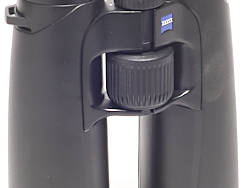 |
|
Click image to enlarge
|
The first thing you notice about focusing on the Victory SFs is that it is very smooth and almost effortless. We noted that
to go from minimum close focus to infinity takes about 1.8 turns of the focus knob, which is about right. This allows for
quite precise focusing of the optic, without taking too long to get there. The rubber used on the focus knob is soft and
molded in broad ridges that almost stick to the fingers, for a very sure feel and action. Both Victory SF models have a
minimum close focus distance of 4.9 feet, which is excellent performance in this character.
User Adjustments
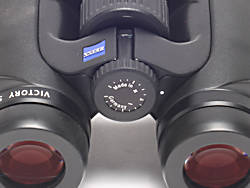 |
|
Click image to enlarge
|
There are several user adjustable features on the Zeiss Victory SF binoculars. The eyecups have much
the same shape and feel as those on both the Victory FLs and the Victory HTs. The helically-adjustable
eyecups move upward (outward) with a counter-clockwise twist, and downward (inward) with a clockwise
twist. Pre-production SFs had two relatively stable detents in between the fully-in and fully-out
positions, meaning that there should be at least one position that is comfortable for most users.
Production SF models we’ve handled since have only one intermediate position marked by a stiff detent.
Both the Victory FL and HT lines had eyecups that tended to collapse during field use, which is
annoying, though hardly a fatal flaw. We hope the SFs have improved in this regard. The Victory FLs
had a locking diopter mechanism hidden under the focus knob: you had to pull the knob up to access
the diopter adjustment mechanism. Operating this was tricky in practice, but at least it did lock.
The Victory HTs had a twisting knob mechanism on the upper bridge around the focus knob. It did not
lock, and even though the knob had a lot of resistance to it, because it didn’t lock, it did tend to
get knocked loose with extended field use, which was again annoying, the more so if your eyes required
an offset position of the knob. The diopter mechanism of the SFs looks very much like the HT diopter
adjustment, except that it locks. You must pop the knob upward to unlock it for adjusting; popping it
down again re-locks it. This is a definite improvement, and we applaud Zeiss for this change.
Caps, Strap and Case
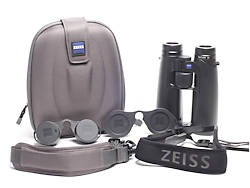 |
|
Click image to enlarge
|
The rainguard on the Victory SFs is pretty nicely executed. Like most rainguards on high end binoculars,
it consists of two soft rubber cups linked by a very flexible bridging segment. The cups are deep and fit
snugly over the ocular lenses, such that once in place, the rainguard does not dislodge inadvertently,
even if the binocular is inverted and shaken. The rainguard has brackets on either side through which
the strap can be threaded, so that it twists away and hangs loosely from the strap when the binocular
is in use. This is as good as a rainguard gets – simple, functional and durable. The objective lens caps,
sadly, closely resemble those of the HTs, which weren’t a great design. These lens caps are made of the
same flexible rubber as the rainguard, and are flanged cups designed to fit up into the armoring of the
barrel ends, and they are linked to form a single piece. In use, they are very easily knocked off
accidentally, despite being difficult to put on to begin with. These could be a lot better. The strap
provided with the Victory SFs is a simple molded foam strap, with leather edging and cordura straps.
We tested this strap for long hours and found it comfortable enough over that time, though honestly,
we would still recommend one of Zeiss's harness straps, now available in standard
and premium versions. The truth is, even if it doesn’t
feel like it, this is still a 27-ounce binocular, and the enhanced control and distributed weight of a
harness makes it more comfortable for long days in the field. The case, on the other hand, is really very
nice, with all sorts of thoughtful features and refinements. The case is pale gray with both a zipper
closure and a magnetically closing flap, the latter presumable being for faster deployment when the
binocular is out of the case. The case has its own strap for added convenience. Inside, there is a mesh
divider that has its own zippered compartment and allows for storage of things like a binocular cloth
or cleaning fluid. While not a hard case, this case is nicely padded inside to provide considerable
protection against shocks, while looking quite classy on the outside
Conclusions
There are many things to like about the Zeiss Victory SF binoculars. The image quality is everything one
could wish for. The dramatically large field of view and very short minimum close focus make these
binoculars wonderful for all kinds of nature observation. And the ergonomics are so superb that these
are easily one of the most comfortable to use binoculars we’ve ever handled. Yes, they are expensive at
$2,999.99 for the 8x42 model, while the 10x42 model sells for
$2,999.99.
Then again, these are designed to be the last binocular you’ll ever need to buy, and their field
performance is simply phenomenal. We suspect that most buyers won’t be experiencing any remorse whatsoever!
Buy Zeiss Victory SF Binoculars